5 Best Dissecting Microscopes of 2024 – Reviews & Top Picks
Last Updated on
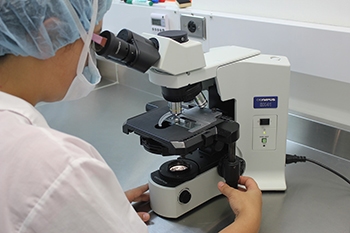
Hobbyists, students, and professionals alike rely on dissecting microscopes for several diverse studies and uses such as geology, archaeology, botany, determining the authenticity of coins and documents, and even appraising jewelry. You can use them to carry out science experiments, complete intricate work on electronics, or even just observe the microscopic world for fun. Whatever your intended use, you’re going to need a microscope that offers certain features such as illuminating lights, adjustable magnification levels, and more.
You may want a portable unit that can run on batteries for performing fieldwork, or you may prefer a highly adjustable model that offers more space for working underneath the objective. To help you find the right microscope for your needs, the following reviews will compare five of our favorites. We’ve tested as many as we can find, and these stood out above the rest. The first three have earned our highest recommendations and after reading these comparisons, we think you’ll agree.
A Quick Comparison of Our Favorites (2024 Update)
| Image | Product | Details | ||
|---|---|---|---|---|
| Best Overall |
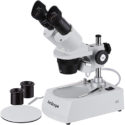 |
AmScope Forward Microscope |
|
CHECK PRICE |
| Best Value |
 |
NATIONAL GEOGRAPHIC Microscope |
|
CHECK PRICE |
| Premium Choice |
 |
Swift Dissecting Microscope |
|
CHECK PRICE |
 |
SOLOMARK Portable Stereo Microscope |
|
CHECK PRICE | |
 |
Celestron S20 Portable Stereo Microscope |
|
CHECK PRICE |
The 5 Best Dissecting Microscopes
1. AmScope Forward Microscope – Best Overall

Equipped with widefield optical glass lenses and a binocular head on a sturdy all-metal frame, the AmScope SE306R-PZ Forward Microscope is a serious tool that’s built for performance. It’s a bit on the expensive side, but we think this is an example of getting what you pay for. While most similar models of dissecting microscopes provide just two levels of magnification, the SE306R-PZ offers 20X, 40X, and 80X, making it one of the most versatile units we’ve seen. Instead of including multiple eyepieces of different magnification levels, AmScope simplified things a bit by including a switchable 2X and 4X objective plus 10X and 20X eyepieces.
You also get upper and lower illumination, so this microscope can double as a compound microscope that illuminates through your slide from the bottom. The lights don’t include dimmers though, and we felt that the transmitted light from below was too bright for most uses. The optical clarity on this device was excellent, and the widefield lenses provided a clear and complete view of every specimen. It was also very comfortable to use thanks to the rubber eye-guards and 45-degree angled head.
- 20X, 40X, and 80X magnification
- Upper and lower illumination
- 2X and 4X switchable objective
- Excellent optical clarity
- No dimmer for the lights
- A bit pricey
2. NATIONAL GEOGRAPHIC Microscope – Best Value
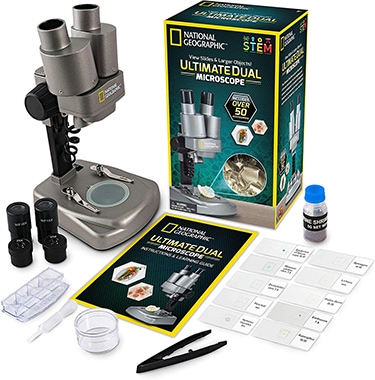
Whether you want to observe 2D specimens on slides or you wish to examine 3D specimens in close-up detail, the NATIONAL GEOGRAPHIC NGMICROSCOPE is an affordable way to get started for anyone. With upper and lower LED lights you get great versatility in how you use this microscope. That said, we did notice that the under-slide illuminator was too bright and there is no dimmer built-in. For beginners, this microscope even includes an accessory kit equipped with everything you need to get started including blank slides, tweezers, eye dropper, petri dish, and more.
This device is equipped with two sets of eyepieces to allow for 20X and 50X magnification. While this is sufficient for most basic work, for professional use you’ll probably want more versatility. The binocular head is also set completely vertically, which we found to be less comfortable than the 45-degree angle found on some of the more expensive models. However, this one comes with a two-year warranty and battery-powered portability that makes it great for field use since you can rest assured that it will be replaced if something were to go wrong. In the end, we think it’s the best dissecting microscope for the money.
- Very affordably priced
- Illumination from above and below
- The included accessory kit is great for beginners
- 20X and 50X magnification
- 2-year warranty
- The under-slide illuminator is too bright
- Not the best choice for professional use
3. Swift Dissecting Microscope – Premium Choice

Our premium choice recommendation, the Swift S41-20 Professional Dissecting Microscope, is a simple yet versatile device that provides more adjustability than most of its competitors. Thanks to the fully adjustable boom arm, you get a complete range of motion along the vertical and horizontal axis. A separate focusing knob allows you to dial in the proper focus after you have positioned the arm properly to give you space to work beneath it. If that’s not enough maneuverability, you also get a working arm that allows for 360-degree swiveling horizontally. Granted, you’re going to be paying a premium for all of these features, but we think it’s definitely worth the price.
This microscope is equipped with just two magnification levels, 10X and 20X. While this is sufficient for most applications, it’s not as strong as other models that included magnification up to 40X and even 80X. However, the Swift S41-20 is also equipped with dual gooseneck LED lights to fully illuminate your work from two different angles. You also get tons of working room beneath the objective lens since there’s no base to take up space. Altogether, we think the Swift microscope is a solid performer that earns its higher price point.
- Dual gooseneck overhead lights
- Boom arm allows for 2-axis adjustments
- Plenty of room to work beneath
- 5-year warranty
- Tons of adjustability
- Only 10X and 20X magnification levels
- On the expensive side
4. SOLOMARK Portable Stereo Microscope
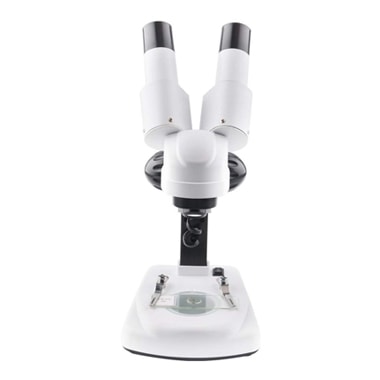
Equipped with two sets of optical glass eyepieces that allow for 20X and 40X levels of magnification, the SOLOMARK portable stereo microscope is an affordable way for students and hobbyists to get a competent piece of equipment. It features dual LED illumination from the top and bottom, allowing this microscope to double as a low-magnification compound microscope that’s excellent for viewing 2D slides. But the real benefit of this device is its portability. It’s very small and lightweight, making it easy to transport. More importantly, the lights run off of two AA batteries, so you can use this unit anywhere. It even includes a smartphone adapter that will let you take pictures and videos of what you’re observing, but we felt it was too difficult to adjust and became frustrated.
Despite the low price and portability, we weren’t very impressed by this microscope. For one thing, the eyepieces aren’t properly lined up, so the image you see isn’t clear. They appear to be looking at different spots instead of being focused on the same area for true stereo imaging. The lightweight and small footprint also lends to a cheap feeling overall and doesn’t inspire confidence in a long lifespan.
- Affordably priced
- Portable
- Smartphone adapter included
- The eyepieces aren’t lined up properly
- Smartphone adapter is difficult to adjust correctly
- Feels cheap like a toy
5. Celestron S20 Portable Stereo Microscope
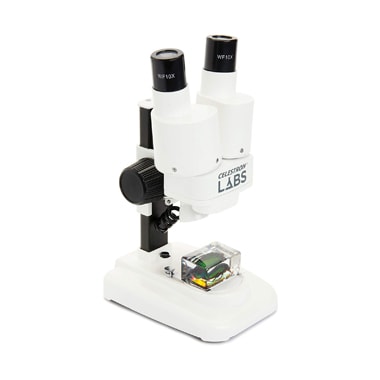
As the cheapest stereo microscope we tested, we really wanted the Celestron S20 to be a solid performer. Unfortunately, the cheap construction and feel of this device perfectly matched its low price. It is very compact and portable though, and the built-in LED light will run off of two AA batteries so you can take this unit anywhere and it will still work. Most similar models also included a light in the base to illuminate slides from below, but the Celestron S20 does not. It’s also pretty limited since you get only a single level of magnification at 20X.
At first, we thought the small size of this unit might be a benefit since it aids in portability. However, when you try to use this microscope, you’ll quickly realize that the small size is more of a hindrance. It’s difficult to work with and there’s not much room for performing work beneath the objective. Despite the small size, we couldn’t get the eyepieces close enough together to get a proper fit for most of our testers’ faces. Overall, even at this low price, we don’t think the Celestron S20 provides enough value to make it a good choice.
- Dirt cheap pricing
- Portable
- No lower illuminator
- Cheap construction and feel
- Can’t get eyepieces close enough together
- Very small and difficult to work on
Buyer’s Guide: Choosing The Best Dissecting Microscopes
Now that you’ve read about some of the best dissecting microscopes on the market, you should have a decent idea of what you’re looking for. To help you clarify your needs even more, we’ve written this short buyer’s guide. In this section, we’ll discuss the traits you should be looking for in a dissecting microscope and how they differ from compound microscopes.
What is a Dissecting Microscope?
Many of us are familiar with the compound microscopes we used in high school with several objective lenses to switch between that offered different levels of magnification. On these microscopes, a lens with a two-dimensional specimen on it was placed onto the microscope base. A light is then shined up through the specimen from the bottom to allow for observation. There is very little distance between the objective and the specimen, so you can get very detailed imaging but you can’t fit any tools beneath the lens.
A dissecting microscope works a bit differently. It’s built to have plenty of room beneath the objective so that you can fit a three-dimensional object and even perform work on it while using the magnification power of the microscope. Because it’s intended for working with larger objects, dissecting microscopes tend to have lower magnification power than compound microscopes. Compound microscopes may have magnification levels of 1000X and even higher, whereas dissecting microscopes tend to top out at 40X, though some go as high as 80X.
While a compound microscope illuminates the specimen from below so that you can see through it, a dissecting microscope illuminates from above to allow you better viewing of the surface of the object. Many modern dissecting microscopes do feature the lower illumination though, so they will double as a compound microscope, albeit a weak one since the magnification level will still be very low.
Dissecting microscopes are also called stereo microscopes because they use separate objectives and lenses for each eye. Compound microscopes on the other hand, only use a single objective, even with a dual-eyepiece design.
Traits to Look for in a Dissecting Microscope
Now that we’ve discussed the differences between a compound microscope and a dissecting microscope, let’s go over some of the traits you should be looking for.
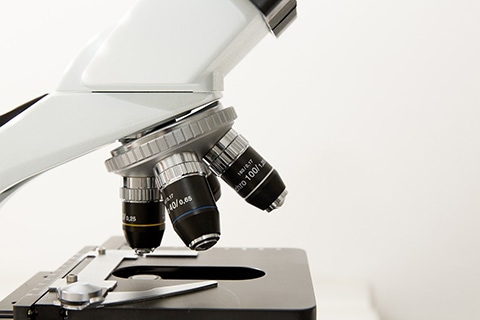
Illumination
Most microscopes today are equipped with some type of illumination. This is necessary to get a clear image of your specimen so you can see all the detail from every angle. Dissecting microscopes will almost always have a light that shines down from above since you’ll be looking at the surface of a three-dimensional object with this tool. Some higher-end models may include two lights from above that allow you to truly immerse your subject in light for the best viewing conditions possible.
Many of these microscopes also feature transmitted lights that shine from beneath your specimen to illuminate it like a compound microscope. This gives you the ability to use slides with two-dimensional specimens, but you’ll still be limited by the low magnification offered by a stereomicroscope.
Portability
Depending on your intended use, you may desire a microscope that can be easily transported for fieldwork. Many newer models feature battery-powered lights that make the unit wireless. Some are also very small and compact, making it easier to take them with you. Be careful though, as these are sensitive instruments that won’t withstand too much jostling. However, some of them come with very respectable warranties that may provide you peace of mind, even out in the field.
Magnification Levels
As discussed, dissecting microscopes are much lower powered than compound microscopes, often topping out at less than 80X magnification. They also tend to offer only two or three levels of magnification to choose from. This is quite different from the six or eight magnification levels offered by some compound microscopes. For most work with a stereo microscope, 10X-40X magnification should suffice. Make sure that the model you choose offers the magnification you need. Some of them only provide a single level of enlargement that may not be adequate for your specific needs.
Comfort
It may seem trivial, but if you’re going to be using your dissecting microscope a lot, you’re going to want to pay attention to how comfortable it is to use. Some models have a completely vertical head, while others feature an angled head, often 45 degrees. We find the angled head design to be much more comfortable since you won’t have to crane your neck to find a good position. Likewise, padded eyecups can make a world of difference over hard plastic ones, especially after several hours of use. We suggest looking for these sorts of comfort features if you’re going to be using your microscope for long hours.
Price
With the most expensive models we tested costing more than four times what the cheapest models do, there’s quite a range of pricing to choose from with these instruments. Generally, quality and feature sets will be reflected in the sticker price, but you’ll have to decide how robust of a device you need. If you’re going to be using it for professional work, then you may do well to invest a bit more in a sturdy model with all the extra features and the most adjustability. If you’re purchasing a microscope for a children’s science class or just to use as a hobbyist, then you may not need every bell and whistle available on the expensive units. Determine what you plan to use this tool for before you make a decision, that way you can pick a unit that’s priced properly for your desired use.

Conclusion
Whether you’re performing detailed and intricate work beneath the objective or you’re just observing the finest details of our macroscopic world, you’re going to need a dissecting microscope with high-quality optical lenses and plenty of adjustability. To that end, we’ve put together this list of reviews that should help you to narrow down your search. Just to make sure our recommendations are fresh in your mind we’re going to summarize them once more. Our favorite overall is the AmScope SE306R-PZ Forward Microscope. Thanks to the switchable 2X and 4X objectives, this device offers 20X, 40X and even 80X magnification levels with excellent optical clarity. You also get upper and lower illumination in a sturdy package that was very comfortable to use.
For the best value, we think it’s hard to beat the NGMICROSCOPE from NATIONAL GEOGRAPHIC. Lightweight, portable, and affordably priced, this unit even includes a two-year warranty. It provides you with 20X and 50X magnification levels, upper and lower illumination, and even an accessory kit to give beginners a head start. Finally, the Swift S41-20 is a high-powered professional device that earned our premium recommendation thanks to its impressive adjustability, dual gooseneck lights, and a five-year warranty.
Featured Image Credit: Herney Gómez, Pixabay
About the Author Robert Sparks
Robert’s obsession with all things optical started early in life, when his optician father would bring home prototypes for Robert to play with. Nowadays, Robert is dedicated to helping others find the right optics for their needs. His hobbies include astronomy, astrophysics, and model building. Originally from Newark, NJ, he resides in Santa Fe, New Mexico, where the nighttime skies are filled with glittering stars.
Related Articles:
How to Clean a Refractor Telescope: Step-by-Step Guide
How to Clean a Telescope Eyepiece: Step-by-Step Guide
How to Clean a Rifle Scope: 8 Expert Tips
Monocular vs Telescope: Differences Explained (With Pictures)
What Is a Monocular Used For? 8 Common Functions
How to Clean a Telescope Mirror: 8 Expert Tips
Brightfield vs Phase Contrast Microscopy: The Differences Explained
SkyCamHD Drone Review: Pros, Cons, FAQ, & Verdict



